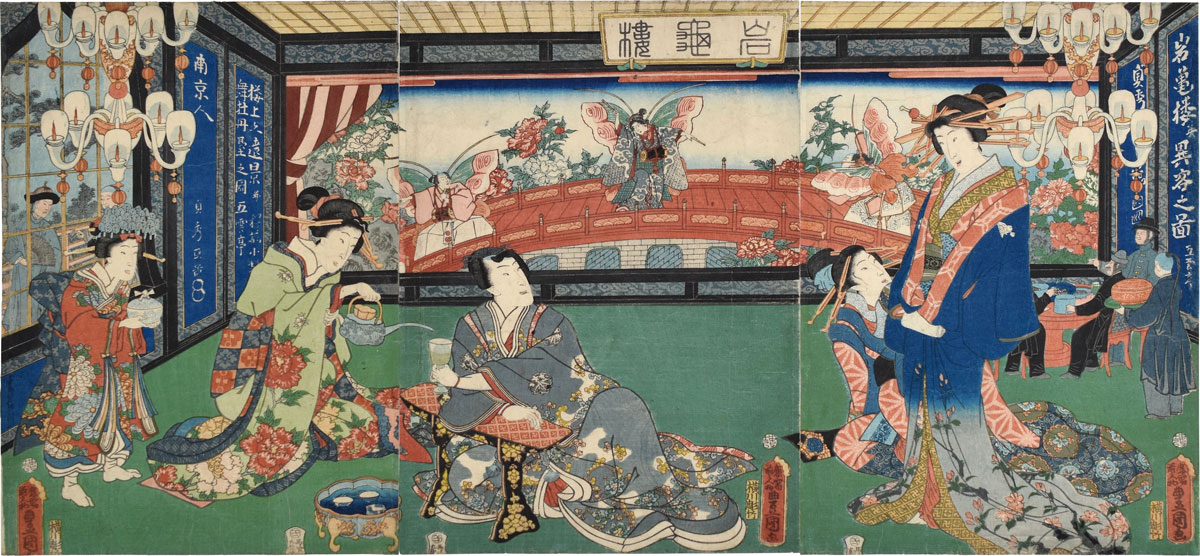

Utagawa Kunisada (Toyokuni III)
1786-1865
Illustration of Uncommon Guests at the Gankiro
(Gankiro ikyaku no zu)
each sheet signed oju-?-jinbutsu Toyokuni ga (on request...by Toyokuni) within artist's Toshidama cartouche, the background designed by Utagawa Sadahide and signed at left on the blue sliding fusuma panels, Nankyojin Sadahide, with block carver's seal of Yokogawa Takejiro and publisher's seal of Maruya Tokuzo, with censor's date seal, November 1860
oban tate-e triptych 13 1/2 by 29 3/8 in., 34.3 by 74.6 cm
This triptych illustrates a rare intersection of Genji-e (pictures inspired by the serialized novel, A Rustic Genji by a Fraudulent Murasaki (Nise Murasaki Inaka Genji) a modern 'update' based on the 10th century courtly novel, The Tale of Genji (Genji Monogatari) with Yokohama-e (pictures of the newly-opened foreigner's port of Yokohama). At center, Mitsuuji (the protagonist of the modern Genji) sits, elegantly as ever, in the company of a ranking courtesan to the right, and attended by her retinue of two shinzo (teenaged apprentices) and one young kamuro (adolescent trainee).
The setting is that of the famous Gankiro house in the licensed pleasure quarter Miyosaki of Yokohama. When it opened in November of 1859, the Gankiro was the only house in the district which offered a special section for the foreigners which was lavishly decorated with Western-influenced details such as crystal chandeliers and glass-paned windows. In return for his investment, the proprietor Hatagoya Sakichi was able to charge as much as four or five times the going rate in Edo. The receiving rooms opened to a courtyard with an arched bridge that functioned as a stage for the Gankiro's famous troupe of young dancers, shown here performing a chocho odori ('butterfly dance') in the background. Mitsuuji holds an imported glass goblet which he holds aloft for the shinzo to refill, incongruously from a sake ewer with a curiously long spout. To the right, Western and Chinese foreigners sit on upright chairs at a table, and to the left we see another Chinese man passing by the glass windows.The indigo fusuma panels are signed by Kunisada's student, Utagawa Sadahide (1807-1873), who would dominate the burgeoning market for images of Yokohama and its foreign residents in the coming years.
Eighteen years after this triptych was published the composition would inspire a lithograph included in Leo de Colange's, The Picturesque World; or, Scenes in Many Lands, published by Estes & Lauriat in Boston.
References:
Julia Meech-Pekarik, The World of the Meiji Print: Impressions of a New Civilization, 1986, pp. 32-33 (on Gankiro)
Yokohama Kaikou 150 Shunen Kinen - Yokohama Ukiyo-e - Kindai Nihon wo Hiraku, Kawasaki Isago No Sato Museum, 2009, pp. 66-67, cat. no. 42
Andreas Marks, Genji's World in Japanese Prints from the Paulette and Jack Lantz Collection, 2012, pp. 250-251, cat. no. 268 and 269 (for 1878 American lithograph)
University of Michigan Museum of Art, accession no. 226915
(inv. no. 10-4926)
price: $2,100






